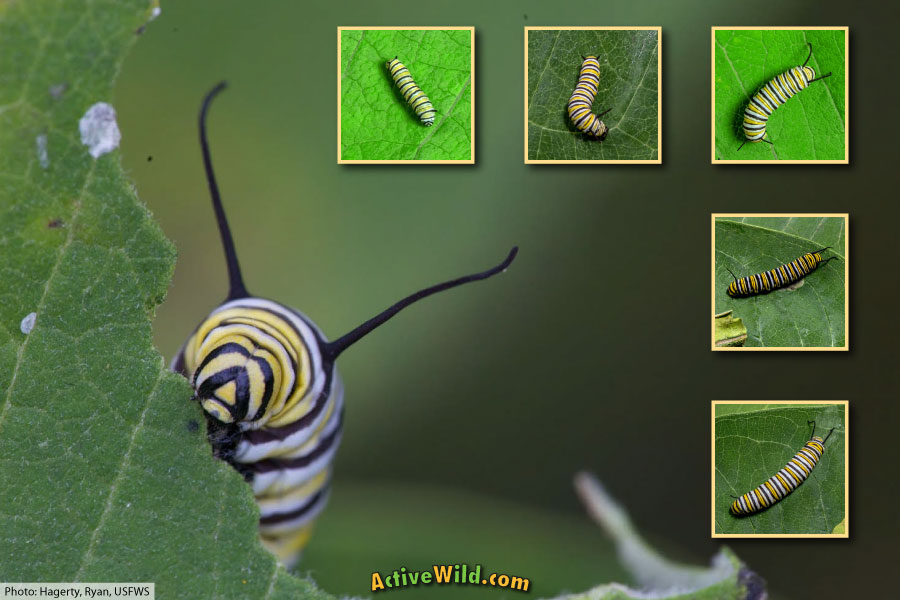Discover information and photographs about monarch caterpillar development.
Egg, larva (caterpillar), pupa (chrysalis), and imago (adult butterfly) are the four stages of development that monarch butterflies go through.
What most individuals don’t realize is that the monarch goes through multiple stages of development as a caterpillar.
The five monarch ‘instars,’ or steps a monarch caterpillar goes through before pupation, will be discussed on this page.
Monarch Caterpillar Stages
The monarch butterfly’s life cycle is divided into four phases: egg, caterpillar, chrysalis, and imago (adult butterfly), as most people are aware.

On this page, you can learn more about the monarch butterfly’s life cycle
The monarch caterpillar goes through five stages of development, which many people don’t realize. The caterpillar molts (moults in British English) at the conclusion of each stage.
The caterpillar is able to continue development by peeling its skin; each stage is bigger and heavier than the previous. At each stage, the caterpillar changes somewhat in appearance.
The monarch caterpillar will have grown to the size and weight required for pupation by the end of the fifth stage of its development. (Chrysalis)
The caterpillar fastens itself to the bottom of a leaf or other appropriate surface before its fifth and final molt. The cocoon in which the caterpillar will metamorphose into a butterfly is exposed during the last molt, which is done while the caterpillar is hanging upside-down.
Instar
The term “instar” refers to a stage in the life cycle of an insect (or other arthropod). The first instar is the newly hatched monarch caterpillar. The second instar, for example, is known after the first molt.
Monarch Caterpillar Stages With Pictures
Temperature influences the duration of each instar for the monarch caterpillar.
Other traits should be taken into consideration when attempting to identify the stage in which a caterpillar is in because there can be significant variations in size between individuals of the same instar. To help you understand what to watch out for, take a look at the images below.
First Instar

The young monarch caterpillar has a lustrous, somewhat transparent body and is light green in color. Over a light green backdrop, it will eventually develop black streaks.
The caterpillar is about 2 to 6 mm in length and has no tentacles at this time. On the caterpillar’s body, there are fine hairs (known as setae).
On hatching, the caterpillar eats its egg then starts eating the leaf of the milkweed plant on which it was laid.

Monarch Caterpillar 1st Instar
The caterpillar eats its egg and then the milkweed plant leaf on which it was placed when it hatches.
Both first and second instar caterpillars will drop from the leaf and dangle by a thin thread if they are disturbed. Silk-producing organs known as spinnerets, which are situated in the caterpillar’s head below the mouthparts, produce the thread.
For one to three days, the caterpillar remains in the first instar stage.
Second Instar

The monarch caterpillar’s body has lost any remaining transparency after the second molt, and its black, yellow, and white stripes are apparent.
The caterpillar’s front tentacles are also visible at this point. The rear tentacles have started to grow, albeit they are still tiny.

Monarch Caterpillar 2nd Instar
A greater number of bristle-like setae are found on the second instar monarch larva.
The length of the second instar monarch larvae is 6 to 9 mm.
In the second instar stage, the monarch caterpillar spends roughly the same amount of time as it did in the first (1–3 days).
Third Instar

Third instar monarch larvae have a length of 10 to 14 mm. Both the front and rear tentacles can now be seen.
While the remaining two pairs are bigger, the front two legs have started to approach the caterpillar’s head somewhat.

Monarch Caterpillar 3rd Instar
If the third instar monarch caterpillars are disturbed, they will fall off the leaf and curl into a ball rather than hanging from a silk thread. The monarch caterpillars have also started eating along the leaf margins at this time.
The monarch spends one to three days in the third instar, depending on temperature, as it did in prior instars.
Fourth Instar

The monarch caterpillar grows to be between 13 and 25 mm long by the fourth instar. The front tentacles are now 5 mm long, whereas the back tentacles are only 2 mm long. White specks on the caterpillar’s prolegs (the 5 pairs of “false” legs at the rear of the larva’s body) are more noticeable.
This stage lasts from 1 to 3 days.

Monarch Caterpillar 4th Instar
Fifth Instar

Monarch caterpillar 5th Instar
The monarch caterpillar grows to be 25 to 55 mm long in its fifth instar. Its front tentacles are roughly 11 mm long, while its rear tentacles are roughly 4 mm. The front legs are significantly smaller than the others and closer to the head, and the white dots on the prolegs are now very visible.

The monarch caterpillar spends between 3 and 5 days in this stage of its development.
The caterpillar is at its most obese and has a virtually fat look at this point. When it looks for a suitable location to pupate, it may be found away from milkweed plants.
The caterpillar makes a silk pad on the bottom of a leaf after finding a suitable location. The chrysalis’ outer surface then emerges from under the skin as it is shed, and it hangs head down from the pad for its fifth and last molt.
The mature monarch butterfly finally emerges after a ten- to fourteen-day period as a chrysallis.
